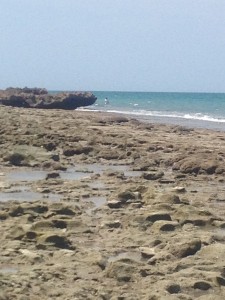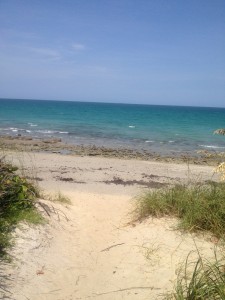Last week I went to Jupiter Island, FL, where the Quaker merchant Jonathan Dickinson was shipwrecked in September 1696. After getting separated from her convoy near Cuba, the barkentine Reformation followed the Gulf Stream up the east coast of Florida into a northwest storm. During the night of the third day, the vessel struck sandy ground that, once the sun came up, looked something like this — 
Jupiter Island is a long flat barrier island, running from Jupiter Inlet north to the town of Stuart. at the St. Lucie inlet near when the Mets play in the spring. Public access to the beaches is now limited to a scattering of state parks, including the one at the town of Jupiter where I swam every morning during my visit. You walk through a dense, inhospitable patch of undergrowth to emerge onto a flat empty beach. We think of this land- and sea-scape as beautiful and relaxing, but for Dickinson’s party is was barren and inhospitable.
It’s hard to tell where exactly on Jupiter Island the ship wrecked — there’s nothing to see today — but it might have been on the rockier stretch of the coast, about 2-3 miles north of the town of Jupiter today.
Dickinson’s party was met by the Jobe (or Jeaga) Indians, who brought them south to their settlement in Jupiter before assisting them to travel north to St. Augustine. The shell-mounds from their settlement still exist, now occupied by an 18c pioneer cabin built on top, in the usual manner of European settlers building on former native sites.
Dickinson’s journal describes the English castaways’ attempts to deceive the Jobe Indians by pretending to be Spanish, with whom the Jobe were allied. The Jobe do not seem to have been very fooled by the one member of Dickinson’s group, a crewman named Soloman Cresson, who was “speaking the Spanish language well” (7). The Jobe called Dickinson’s group “Nickaleers,” which they pretended not to understand meant English.
Relations with the Jobe were ambivalent; Dickinson and his group lost most of their clothes and goods, but a Jobe woman suckled Dickinson’s four-month old son, who survived the voyage and went on to a prominent life in trade in Philadelphia. The modern edition of Dickinson’s journal that I have on my desk, published by Florida Classics Library, subtitles it
A true story of shipwreck and torture on the Florida coast in 1696
but the torture part seems exaggerated. The Jobe started Dickinson’s party in their journey north, which took them through several different Indian groups, to St Augustine by mid-November, where they were helped, not persecuted, by the Spanish governor, and eventually to Charles Town on Dec 26. From their they took sail to Philadelphia, their original destination, where Dickinson’s memoir was published in 1699.
Dickinson apparently wasn’t discouraged by his shipwreck, since he made several more sailing trips to Jamaica, where he was born, to tend to his expanding trade network. He was twice Mayor of Philadelphia, in 1712-13 and 1717-19, before dying in that city in 1722 at the age of 59.
Spending a couple days near the shipwreck site gave me a taste of the hot and inhospitable coast of south Florida. Dickinson’s party split up on the voyage north, with the weaker members in a small boat and the bulk of the party, including Dickinson’s slaves, trudging up the beach. The water is clear, warm, and full of light. Every time I swam I saw schools of bait fish, and the local pelicans clearly were getting bigger game. Plenty of seaweed, and the 20′ high oyster middens of the Jobe settlement testify to a wealth of seafood that’s not very visible on the bottom today.
It’s an empty, inhuman space, now occupied by mansions, air conditioning, and power boats. Hard to imagine a party of Quakers on that beach today.



Florida is an ecological catastrophe of a state, but a visit to most any part of its coast is a reminder of the transnational vectors that cross its early history. You mention the Spanish and English; the French also tried christening its rivers after their rivers, and so on. AND everyone had vexed relations (seldom honest relations) with those who already dwelled there. Yet the state of course isn’t all that interested in this complicated history, it seems so enamored of development and making the land yield to human impress.
“An empty and inhuman space occupied by mansions, air conditioning, and power boats”: WOW.
I’ve been reading a little bit about the French Huguenot colony on the St John river a bit north of St Augustine. Massacred by a Spanish force led by Don Pedro de Menedez y Avila in 1563, “not as Frenchmen, but as Lutherans.” A musicologist at the JCB conference in June said that one lasting trace of this colony was musical: a generation later, the Indians apparently still sang the Protestant hymns that the Huguenots taught them.
St. Augustine is better than south FL about remembering its past, but I don’t think they emphasize this part.
It was in St Augustine that I bought my copy of Rene Laudonniere’s Three Voyages a few years ago, but most of the history that is celebrated there was Spanish and English.
Hey Steve,
I fell onto this site by just researching information about J. Dickinson. I was inspired by this story after reading excerpts of his notes in various printings. I live in Orlando and hope to visit the park soon.
I am also a screenwriter and have basically taken the story from Dockside in Jamacia, to Philadelphia. I have captured all of the events, dialogue, and action as per the events that I have researched.
I was wondering if you have any good outline of events so I can check my outline of the story to ensure technical accuracy.
I did not know what happened to his son and your blog here provides some neat info. The reason is that one of the main narratives is ensuring the baby’s survival.
I hope to hear from you soon, even for a chat about Florida.
Thanks,
JC Leach